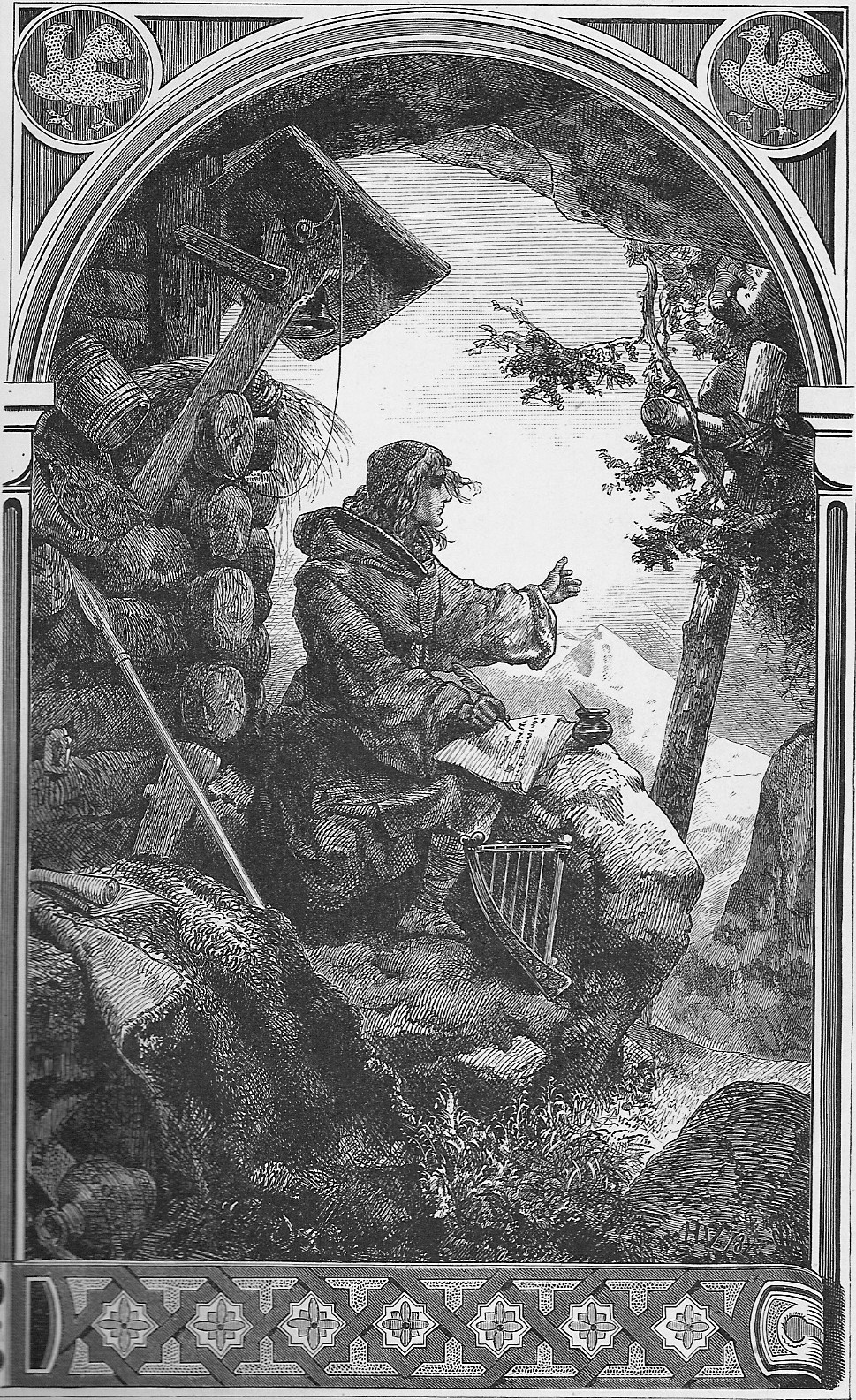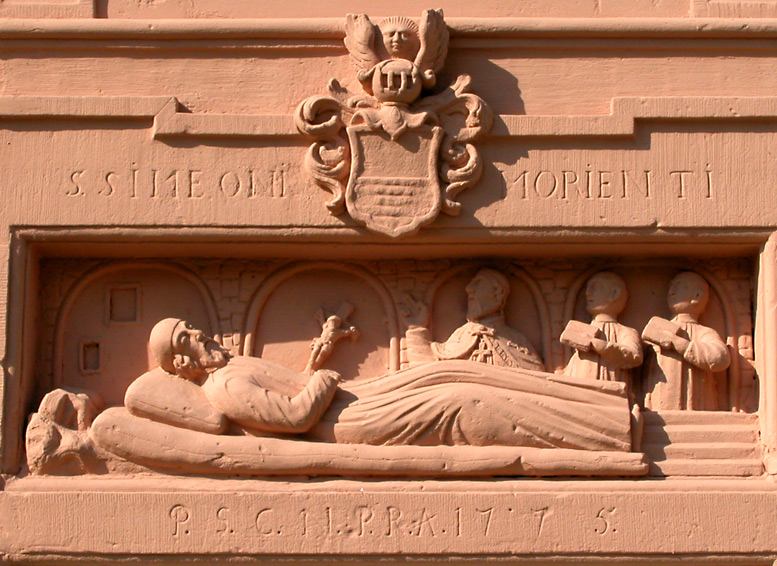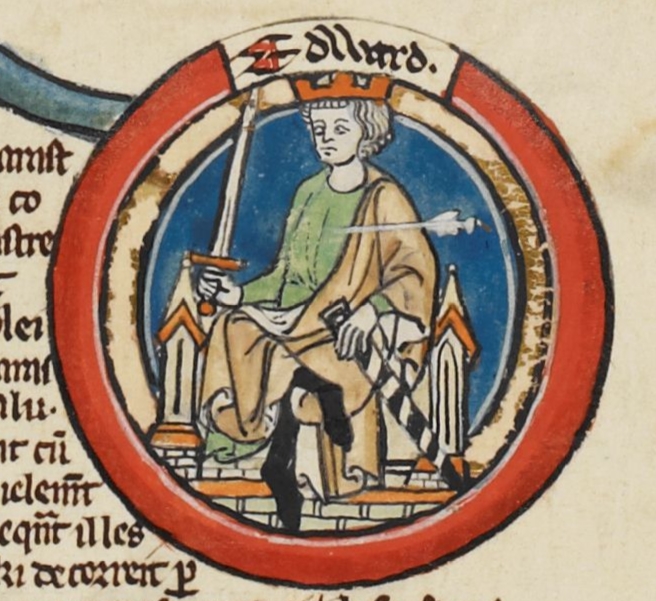|
Purchart I
Purchart I (born c. 920/930; died 9 August 975) was the abbot of the Benedictine abbey of Saint Gall from 958 until 971. Life Purchart came from the family of the Udalrichings ( Udalrichinger). His father was probably count Ulrich V; his mother was named Wendelgard. He was probably born between 920 and 930. He came into the Abbey of Saint Gall at a young age as an oblate and was made deacon under Craloh. His first documented mention is dated at 959/60. His predecessor Ekkehart I, whom Craloh had selected to be his successor, but an injury following a riding accident prevented him from holding office. Ekkehart I thus selected Purchart to be successor and he subsequently became abbot. However, due to also being injured in a riding accident, he could not attend to all of his duties. He received the confirmation of immunity and all other rights and possessions from Pope John XIII in 967. Works Purchart was very popular with the monks due to his benevolence. However, economy and ... [...More Info...] [...Related Items...] OR: [Wikipedia] [Google] [Baidu] |
Abbey Of Saint Gall
The Abbey of Saint Gall (german: Abtei St. Gallen) is a dissolved abbey (747–1805) in a Catholic religious complex in the city of St. Gallen in Switzerland. The Carolingian-era monastery existed from 719, founded by Saint Othmar on the spot where Gallus had erected his hermitage. It became an independent principality between 9th and 13th centuries, and was for many centuries one of the chief Benedictine abbeys in Europe. The library of the Abbey is one of the oldest monastic libraries in the world. The city of St. Gallen originated as an adjoining settlement of the abbey. The abbey was secularized around 1800, and in 1848 its former church became a Cathedral. Since 1983 the abbey precinct has been a UNESCO World Heritage Site. History Foundation Around 612 Gallus, according to tradition an Irish monk and disciple and companion of Saint Columbanus, established a hermitage on the site that would become the monastery. He lived in his cell until his death in 646, and wa ... [...More Info...] [...Related Items...] OR: [Wikipedia] [Google] [Baidu] |
Oblation
Oblation, meaning "the act of offering; an instance of offering" and by extension "the thing offered" (Late Latin ''oblatio'', from ''offerre'', ''oblatum'', to offer), is a term used, particularly in ecclesiastical use, for a solemn offering, sacrifice or presentation to God, to the Church for use in God's service, or to the faithful, such as giving alms to the poor. Bible use The Latin Vulgate, and following this many English versions such as the KJV, 1611, uses the word to stand for the meal offering under the Law of Moses. Ecclesiastical use It is thus applied to certain parts of the Eucharistic service in Christian liturgies. The rites of Roman Catholicism, Eastern Orthodoxy, Anglicanism, and some Lutheran churches employ an oblation: gifts of bread and wine are offered to God.C. Souvay (1911)Offerings In ''The Catholic Encyclopedia''. New York: Robert Appleton Company. Retrieved April 12, 2011 Liturgically speaking, there are two oblations: the lesser oblation, sometime ... [...More Info...] [...Related Items...] OR: [Wikipedia] [Google] [Baidu] |
Ekkehard I
Ekkehard I ( la, Eccehardus; died 14 January 973), called ''Major'' or ''Senex'' (the Elder), was a monk of the Abbey of Saint Gall. He was of noble birth, of the Jonschwyl family in Toggenburg, and was educated in the monastery of St. Gall; after joining the Benedictine Order, he was appointed director of the inner school there. Later, under Abbot Kralo, who trusted him implicitly, he was elected dean of the monastery, and for a while directed all the affairs of the abbey. Ekkehard made a pilgrimage to Rome, where he was retained for a time by Pope John XII, who presented him with various relics of St. John the Baptist. After Kralo's death Ekkehard refused the abbatial succession, because of lameness resulting from a fractured leg. However, he directed the choice of Burkard, son of Count Ulrich of Buchhorn, who governed St. Gall with the advice and co-operation of Ekkehard. The latter erected a hospice in front of the monastery for the sick and strangers, and was in many other ... [...More Info...] [...Related Items...] OR: [Wikipedia] [Google] [Baidu] |
Pope John XIII
Pope John XIII ( la, Ioannes XIII; died 6 September 972) was the bishop of Rome and ruler of the Papal States from 1 October 965 to his death. His pontificate was caught up in the continuing conflict between the Holy Roman emperor, Otto I, and the Roman nobility. After long and arduous negotiations, he succeeded in arranging a Byzantine marriage for Otto II, in an effort to legitimize the Ottonian claim to imperial dignity. He also established church hierarchy in Poland and Bohemia. Family and early career Born in Rome, John was the son of another John, who was a bishop. It has been conjectured that his father was the Roman noble John Crescentius, a member of the Crescentii family who had married into the family of Count Theophylact I of Tusculum. If so, his father had previously been a duke, and possibly even appointed consul, prior to his ordination as bishop.Mann, pg. 286 Consequently, John was probably the brother of Crescentius the Elder (the ''Patrician (post-Roman Europe), ... [...More Info...] [...Related Items...] OR: [Wikipedia] [Google] [Baidu] |
Recluse
A recluse is a person who lives in voluntary seclusion from the public and society. The word is from the Latin ''recludere'', which means "shut up" or "sequester". Historically, the word referred to a Christian hermit's total isolation from the world, with examples including Symeon of Trier, who lived within the great Roman gate Porta Nigra with permission from the Archbishop of Trier, or Theophan the Recluse, the 19th-century Orthodox Christian monk who was later glorified as a saint. Many celebrated figures of human history have spent significant portions of their lives as recluses. Causes There are many potential reasons for becoming a recluse, including but not limited to: a personal philosophy may reject consumer society; a mystical religious outlook may involve becoming a hermit or an anchorite; a survivalist may be practicing self-sufficiency; a criminal might hide away from people to avoid detection by police; or a misanthrope may lack tolerance for society. In the Ru ... [...More Info...] [...Related Items...] OR: [Wikipedia] [Google] [Baidu] |
Conrad Of Constance
Conrad of Constance (german: Konrad von Konstanz; la, Conradus, Curtius; 900 26 November 975) was a German bishop and saint. Life Conrad was a member of the powerful Elder Welfs, Welf family, son of Count Heinrich of Weingarten (Württemberg), Altdorf. After an education at the cathedral school in Konstanz, Constance, he became provost of Constance Cathedral and in 934 was made Bishop of Constance. It is counted as one of his achievements that he avoided becoming enmeshed in the politics of the day and reserved his energies for his episcopal duties. He was nevertheless close to Otto I, Holy Roman Emperor, Emperor Otto I, whom he accompanied to Italy in 962. Conrad made three pilgrimages to Jerusalem as well as a number to Rome. He founded a number of churches on the episcopal estates and the hospital at Kreuzlingen, named after a portion of the True Cross which Conrad brought back from Jerusalem and presented to it. Veneration His remembrance as a role model for courage was en ... [...More Info...] [...Related Items...] OR: [Wikipedia] [Google] [Baidu] |
10th-century Births
1 (one, unit, unity) is a number representing a single or the only entity. 1 is also a numerical digit and represents a single unit of counting or measurement. For example, a line segment of ''unit length'' is a line segment of length 1. In conventions of sign where zero is considered neither positive nor negative, 1 is the first and smallest positive integer. It is also sometimes considered the first of the infinite sequence of natural numbers, followed by 2, although by other definitions 1 is the second natural number, following 0. The fundamental mathematical property of 1 is to be a multiplicative identity, meaning that any number multiplied by 1 equals the same number. Most if not all properties of 1 can be deduced from this. In advanced mathematics, a multiplicative identity is often denoted 1, even if it is not a number. 1 is by convention not considered a prime number; this was not universally accepted until the mid-20th century. Additionally, 1 is ... [...More Info...] [...Related Items...] OR: [Wikipedia] [Google] [Baidu] |
975 Deaths
Year 975 ( CMLXXV) was a common year starting on Friday (link will display the full calendar) of the Julian calendar. Events By place Byzantine Empire * Arab–Byzantine War: Emperor John I raids Mesopotamia and invades Syria, using the Byzantine base at Antioch to press southwards to Tripoli. He conquers the cities of Baalbek, Damascus, Sidon, Tiberias and Caesarea, but fails to take Jerusalem. Europe * October 15 – Oberto I (Obizzo), an Italian count palatine, dies. The Marca Obertenga (Eastern Liguria) is divided among the Obertenghi family. * Emperor Otto II (the Red) leads a punitive expedition against Boleslaus II, duke of Bohemia (approximate date). England * July 8 – King Edgar I (the Peaceful) dies at Winchester after a 16-year reign. He is succeeded by his 12-year-old son Edward II (the Martyr) as ruler of England. Africa * December 21 – Caliph Al-Mu'izz dies in Egypt after a 22-year reign in which he has extended his realm from ... [...More Info...] [...Related Items...] OR: [Wikipedia] [Google] [Baidu] |
Year Of Birth Uncertain
A year or annus is the orbital period of a planetary body, for example, the Earth, moving in Earth's orbit, its orbit around the Sun. Due to the Earth's axial tilt, the course of a year sees the passing of the seasons, marked by change in weather, the hours of daylight, and, consequently, vegetation and soil fertility. In temperate and subpolar climate, subpolar regions around the planet, four seasons are generally recognized: spring (season), spring, summer, autumn and winter. In tropics, tropical and subtropics, subtropical regions, several geographical sectors do not present defined seasons; but in the tropics#Seasons and climate, seasonal tropics, the annual wet season, wet and dry seasons are recognized and tracked. A calendar year is an approximation of the number of days of the Earth's orbital period, as counted in a given calendar. The Gregorian calendar, or modern calendar, presents its calendar year to be either a common year of 365 days or a leap year of 366 days, a ... [...More Info...] [...Related Items...] OR: [Wikipedia] [Google] [Baidu] |
Abbots Of Saint Gall
Abbot is an ecclesiastical title given to the male head of a monastery in various Western religious traditions, including Christianity. The office may also be given as an honorary title to a clergyman who is not the head of a monastery. The female equivalent is abbess. Origins The title had its origin in the monasteries of Egypt and Syria, spread through the eastern Mediterranean, and soon became accepted generally in all languages as the designation of the head of a monastery. The word is derived from the Aramaic ' meaning "father" or ', meaning "my father" (it still has this meaning in contemporary Hebrew: אבא and Aramaic: ܐܒܐ) In the Septuagint, it was written as "abbas". At first it was employed as a respectful title for any monk, but it was soon restricted by canon law to certain priestly superiors. At times it was applied to various priests, e.g. at the court of the Frankish monarchy the ' ("of the palace"') and ' ("of the camp") were chaplains to the Merovingian and ... [...More Info...] [...Related Items...] OR: [Wikipedia] [Google] [Baidu] |


.png)




